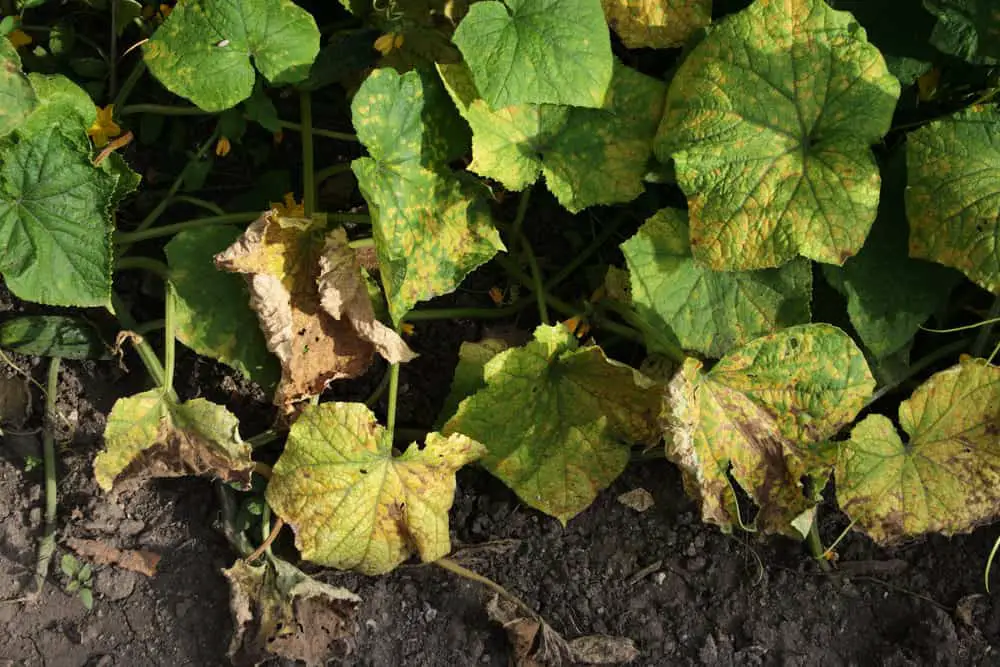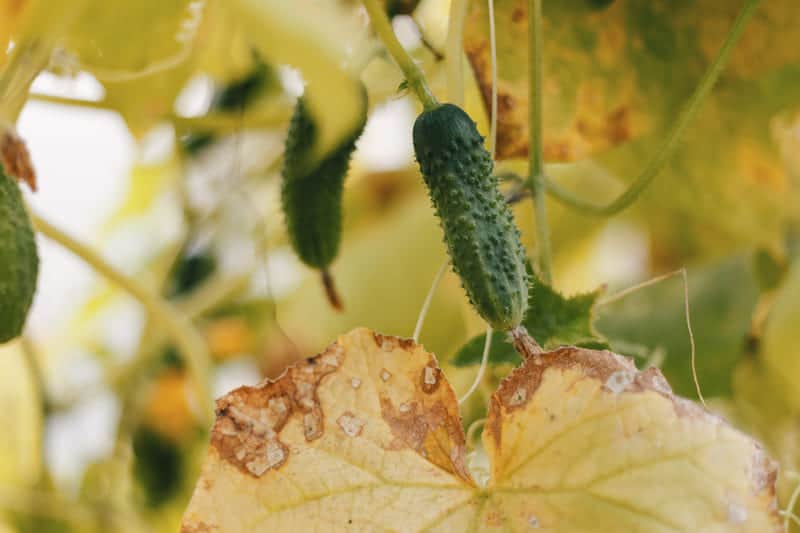There are various reasons why your cucumber leaves may turn brown. Is this a greenhouse cucumber, one in a pot, or an outdoor cucumber plant?
Cucumber leaves turning brown may indicate over-watering, disease, pest infestation, or insufficient light. Ensure the plant is planted in well-draining soil and not being watered too frequently.
Provide adequate light and consider relocating the plant if it is not receiving enough light. Over-fertilizing can also cause browning, so be careful not to over-fertilize.
Run through this initial checklist below, and then read on to solve common leaf problems with your cucumber plant.
What causes brown leaves in cucumber plants?
Your cucumber plants’ leaves can turn brown due to several reasons such as the following. Please, read the possible causes and prevent this from happening in the future.
1. Watering or overwatering usually
Cucumber plants are very thirsty plants indeed and on summer days they need even more water.
Remember that it is important to be consistent with watering too. This is super easy in a greenhouse or on a balcony pot.
You can set up an automatic watering system for 2 daily doses early morning and in the evening. Check the plant during really hot weather.
If your cucumber plant is also wilting in addition to the brown leaves, then top up with a fertilizer once a week when they are in fruit.
Read on to learn how to treat an overwatered cucumber below.
2. Check sunlight and heat
All cucumber plants, whether indoor or outdoor, need at least 5 hours of sunshine (more is better) and they also need a minimum temperature of 70°Fahrenheit (21ºC) to thrive.However, if leaves indoors are brown, it might be as a result of sun-scald.
If this is the case, you may need to shade (blind, material, or cardboard) your greenhouse during the hottest time of the day.
You can also buy special greenhouse paint from a hardware store.
3. Rich soil is essential
Brown leaves can be a result of poor soil conditions.
Meaning, if the soil is lacking in nutrients or if it is not sterilized, then cucumber plants are very vulnerable to diseases. These diseases can cause mottled leaves, brown and discolored leaves, and even stem rot.
The disease can happen in unsterilized soil. Thus, make sure your soil is good to start with. Check disease symptoms below and how to fix them.
4. The weather
Either too wet or too sunny or too cold, your cucumber plant needs lots of attention.
Do not plant outdoors plants until it is frost-free; ensure the plants are not in a windy place or with cold drafts at night. Leaves show the state of your cucumber plant – if they are brown, it means they may be too cold or in a draft.
Shut that greenhouse door!
5. Disease
Check the rest of the plant beside the leaves. Is the stem also brown? Is the whole plant wilting and collapsing?
This may be stem rot – see overwatering in FAQs.
Read on to correct this and identify other leaf problems caused by disease.
- Anthracnose: Also known as leaf spot; it causes leaves to discolor with brown spots, edged with yellow, and finally, the whole leaf turns brown.
- Cucumber Blotch: It causes leaves to discolor really quickly, with brown spots on the leaves – stems are unaffected.
- Mildew: The leaves seem to have a fine, powdery, white dust all over them and the stems are also affected.
- Cucumber mosaic virus: The leaf surface shows discoloration, sometimes yellow or sandy brown. The leaf distorts and wilts, and in extreme cases, the whole plant collapses.
- Verticillium wilt: It starts with yellowing leaves, which later turn brown.
How can I fix these problems?

It is caused by greenfly so take preventative measures immediately. Soapy dishwater will help or try permethrin if this doesn’t work. Remove plant and destroy the whole thing.
Verticillium wilt can affect young plants in cold, wet conditions. So keep the air warm and moist, use cloche outdoors if necessary and grow cucumbers in sterilized soil.
The browning leaf with webs means that you have a red spider mite. This is a common problem in greenhouses. You need to keep the greenhouse damp by spraying and also use a mixture of dish soap and water to spray the leaves and webs.
Then wipe down the affected leaves with a cloth to remove the insects. These leaves may not recover so cut and destroy them. Keep your eye out for webs and deal with them early on to avoid a recurrence.
Your outdoors cucumber in the soil:
The weather is a primary factor in causing brown leaves if your plant is in soil outdoors.
If there is also bad drainage, whole young plants can turn brown, wilt, and die. Root and stem rot can also develop in conditions like these.
If there is a wet patch of weather then grey mold (Botrytis) can appear on the developing fruit. To avoid this, pick and destroy the affected fruit and the leaves.
If possible wipe the rest of the leaves down carefully, cleaning the sponge each time to avoid spreading the disease. This is a disease of damp weather, thus do some sun dances, as this plant certainly does not need more rain!
Your outdoors cucumber in a pot:
Mildew often gets white powdery mold on leaves, which usually occurs outdoors in a warm, dry summer.
It can be avoided by keeping the soil moist; add a layer of mulch to the area around the stem to conserve moisture.
Should I remove dead leaves from the cucumber plant?
Definitely, but do not add diseased leaves to compost or infection may spread.
It should be added that brown leaves in an older cucumber plant may be simply due to old age!
If there were no obvious diseases, then just cut leaves off and add to compost as normal.
FAQs
What do overwatered cucumbers look like?
Yellow leaves are usually a sign of this.
First, let the plant dry out a bit. The drainage is really important so check the roots and if they are drenched, you may need to re-pot.
Clean, sterilized compost may save this plant. Be consistent in your watering habits from now on – refer to number 1 above.
Do I need to remove flowers from a cucumber?
If your plant has both male and female flowers, then yes, you do need to remove the male flower.
You will be able to spot this because the flowers are quite different.
The male flower has a long creamy white pollen tube in the center of the flower while the female flower has a tiny fruit already present behind it, which is known as an ovary. And this is the flower to keep! If you do not remove the male flower, the cucumber often tastes really bitter.
Why do my cucumbers taste bitter?
The first cause of bitterness is that male flowers need to be removed.
Check the final tips below on how to recognize which flower is male. If you do not, your cucumber may look strangely shaped and taste bitter.
The second cause is overwatering so try to have a consistent routine.
Final tips
Mist leaves regularly in a greenhouse during hot weather but not at the hottest period of the day, between 12 noon and 3 pm.
If you water or mist the leaves during this time, the drops of water formed may act as a magnifying glass and scald the poor leaves even more.
Removing male flowers from plants is necessary to avoid bitter fruit. The female flowers have a little fruit forming behind them; male flowers do not. So remove the male ones and enjoy your cucumbers.

